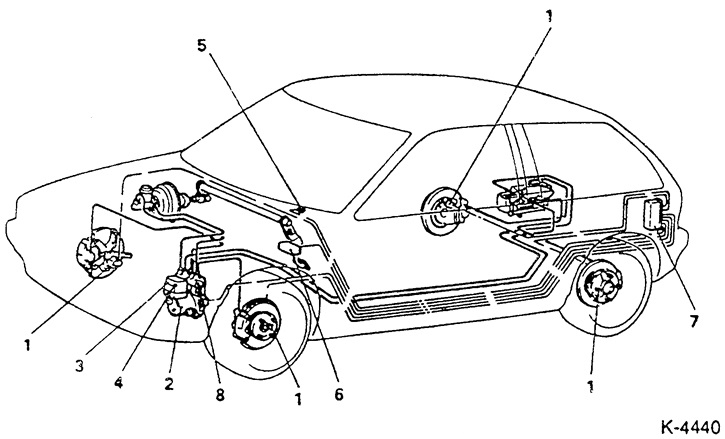Anti-lock braking system (ABS) prevents the wheels from locking during heavy braking. Thanks to this, even with full braking, the car remains steerable.
ABS starts to work with the ignition on, starting at a speed of 6 km / h. First, the control unit performs a performance test of the entire system, and then the process of regulating all braking processes in the blocking range begins.
Based on the signals from the speed sensors, one installed on each wheel, the electronic control unit calculates the average speed, approximately corresponding to the speed of the vehicle. By comparing the rotation speed of each individual wheel with the average calculated speed, the electronic unit determines the slip state of the individual wheel and thereby determines which wheel is in the pre-lock state.
As soon as the wheel becomes prone to blocking, that is, the brake fluid pressure in the caliper of this wheel is too high in relation to the traction force of the wheel with the road, the braking hydraulic system, on the signals of the electronic unit, keeps the pressure in the caliper of this wheel constant. That is, the pressure remains constant as the brake pedal is pressed harder. If the tendency to lock up persists, the pressure decreases due to fluid flowing out through the exhaust valve hole, but as soon as the wheel speeds up again, the pressure becomes constant again.
When a certain wheel speed is reached, the hydraulic system increases the pressure, but not more than the total braking pressure.
This process is repeated under heavy braking for each wheel until the foot is removed from the brake pedal or shortly before the vehicle comes to a complete stop (approximately at a speed of 2-3 km/h) The driver feels the operation of the ABS system by the pulsation of the brake pedal.
Emergency shutdown system ensures that the ABS system is disabled in case of failure (e.g. broken wire) or at low voltage (below 9.5V). In this case, when driving, the ABS warning lamp lights up on the dashboard. The normal braking system functions normally. That is, the car behaves as if the ABS system is not installed on it.
When the ABS warning lamp comes on while driving, the ABS system is deactivated.
Stop briefly, turn off and start the engine again.
Check battery voltage. If it is below 9.5 V, charge the battery.
Attention: If the ABS warning light comes on at the beginning of a trip and then goes out, this indicates that the battery voltage was low, but then, while driving, increased due to recharging from the alternator.
Check the fastening and reliability of contact of the battery terminals.
Raise the car, remove the front wheels, check the integrity of the wiring of the wheel speed sensors.
Check of system ABS with use of a control lamp
Check the tightness of the brake system and the connections of the brake pipes and hoses.
Turn on the ignition. The ABS warning lamp should light up.
Start the engine. After starting, the control lamp should flash 2 times for a short time (about 0.5 sec).
Let the engine run at idle for about 2 minutes. At this time, the ABS warning lamp should not light up.
Take a short test drive (about 1 minute). In this case, the speed must be above 30 km / h. At this time, the ABS warning lamp should not light up.
In case of malfunctions in the ABS system, contact a service station.
Disabling the ABS system
Pull out the ABS fuse. The fuse is in the fuse box on the left (in the direction of travel) behind the battery.

1 - Wheel rotation sensor
Transmits a wheel rotation signal to the electronic control unit
2 - Hydraulic block
Regulates brake fluid pressure for each individual wheel
3 - Motor relay
Controlled by an electronic control unit and turns on the pump motor in the hydraulic unit
4 - Valve relay
Provides voltage to the solenoid valve in the hydraulic unit
5 - ABS warning lamp
Located on the dashboard and lights up when the ABS system fails
6 - Diagnostic connector
Used to read fault codes
7 - Control unit
It is located behind the left trim of the luggage compartment and controls the hydraulic unit according to signals from sensors
8 - Level selection valve (Select-Low)
Located in the hydraulic block and prevents one-sided blocking of one rear wheel
